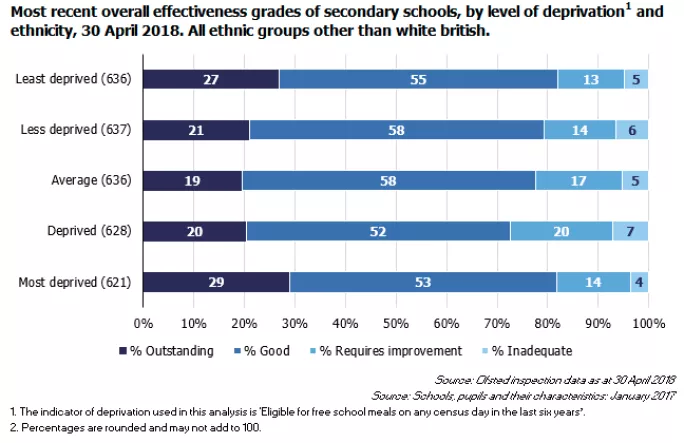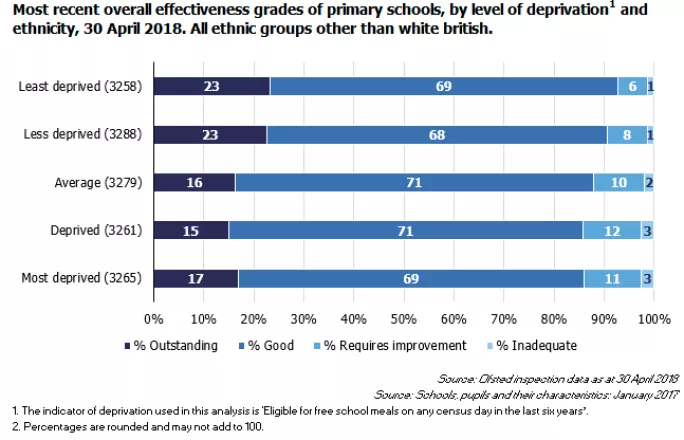
- Home
- More white working-class schools are ‘inadequate’
More white working-class schools are ‘inadequate’

Schools in poor white communities are much more likely to be rated "inadequate" or "requires improvement" by Ofsted compared with those in deprived, non-white British areas.
While nearly half (47 per cent) of the most deprived secondary schools with a "high percentage" of white British pupils are rated "inadequate" or "requires improvement", the proportion is just 18 per cent for similarly deprived schools where most pupils are non-white British.
The startling figures are contained in an Ofsted analysis of its own data seen by Tes.
The revelation follows claims, first reported by Tes, that the Progress 8 accountability measure penalises secondary schools in “white working class communities” where there are few pupils who speak English as an additional language (EAL).
According to the Ofsted analysis, there are significant differences in inspection results between schools based on their ethnic make-up.
The latest Ofsted data on schools’ overall effectiveness, which goes up to 30 April 2018, shows that of schools with a high non-white British pupil population, 29 per cent in the most deprived quintile were rated "outstanding".

This meant that the most deprived quintile had the highest proportion of outstanding schools in this group of schools.
However, for white British schools in the most deprived quintile, just 4 per cent were rated "outstanding".

These schools were much more likely to be rated "inadequate" or "requires improvement" compared with non-white British schools in the same quintile.
In the white British schools, 14 per cent were rated "inadequate" and 33 per cent were "requires improvement". For the non-white British schools, only 4 per cent were rated "inadequate" and 14 per cent "requires improvement".
Progress 8 inequality?
The difference in inspection ratings between deprived white British and non-white British is much more pronounced at secondary level than for primaries.
At primary level, among schools with a high percentage of non-white British pupils and high levels of deprivation, 17 per cent were rated "outstanding" and 69 per cent "good".
For primary schools with a high percentage of white British pupils and high levels of deprivation, 8 per cent were rated "outstanding" and 72 per cent were rated "good".


In its own commentary on the data, Ofsted notes how ethnicity seems to account for a bigger gap at secondary level. “For primary schools, there is a six percentage point difference [in the percentage of schools rated 'good' or 'outstanding'] between schools with a high percentage of white British pupils combined with high levels of deprivation, compared to all other ethnic groups with high levels of deprivation.
“For secondary schools, there is a 29 percentage point difference between schools with a high percentage of white British pupils combined with high levels of deprivation, compared to all other ethnic groups with high levels of deprivation.”
The data will fuel concerns that at secondary level, Progress 8 is loaded against schools in white working-class communities, which is, in turn, feeding into poorer Ofsted ratings.
In April, Tes revealed analysis by Ian Butterfield, a Wigan headteacher and former research scientist, which appeared to show that Progress 8 scores were influenced by a school’s level of deprivation and the size of its EAL cohort. The analysis showed that as the proportion of EAL pupils increased, so too did the average Progress 8 score.
It has been suggested that schools with a large EAL cohort may have inflated progress scores, because key stage 2 Sats – used as the baseline for Progress 8 – will underestimate some EAL pupils’ initial academic ability if children take them before they have reached fluency in English.
At the time, Mr Butterfield warned that this aspect of Progress 8 would result in Ofsted harshly judging schools in white working-class communities.
“Ofsted would argue that [Progress 8] is just one element,” he told Tes. “But there’s a huge correlation between judgements of schools and their Progress 8 score. If you’ve got a positive Progress 8 score, you’re highly unlikely to suffer, and if you’ve got a negative Progress 8 score, you’re going to be under scrutiny.”
James Eldon, the principal of Manchester Enterprise Academy – a school in Wythenshawe that has a high degree of deprivation and where 90 per cent of pupils are white British – told Tes that he was "flabbergasted" by the Ofsted data.
“In my context, only 4 per cent of those 634 schools [most deprived white British schools] are 'outstanding'. In the least deprived [quintile], 58 per cent are outstanding.
"I’m a bit shattered by it really. One still had the belief that there was a genuine equity.
"It feels quite unsettling that there’s not a strategic conversation at the very highest levels of the department and the inspectorate to say, 'Look, [Progress 8] is creating this dynamic.'”
Ofsted has been contacted for comment.
Register with Tes and you can read five free articles every month, plus you'll have access to our range of award-winning newsletters.
Keep reading for just £4.90 per month
You've reached your limit of free articles this month. Subscribe for £4.90 per month for three months and get:
- Unlimited access to all Tes magazine content
- Exclusive subscriber-only stories
- Award-winning email newsletters
You've reached your limit of free articles this month. Subscribe for £4.90 per month for three months and get:
- Unlimited access to all Tes magazine content
- Exclusive subscriber-only stories
- Award-winning email newsletters



